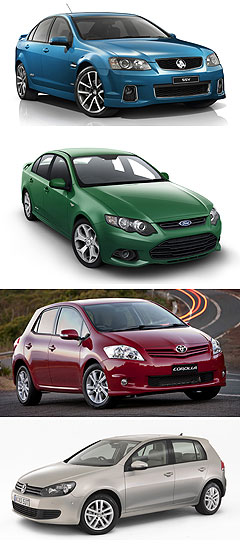Market Insight: Small is the new big
BY DAVID HASSALL | 8th Nov 2011

While sales in the three other main passenger car segments are all down this year, breaking the recent upward momentum in the light and medium segments, small-car sales have continued to flourish and are ahead by 1.8 per cent year-to-date.
That puts the small-car segment on track for a record 240,000 units in 2011 – 25,000 more than last year and some 80,000 units ahead of where the segment was just 10 years ago.
In percentage terms, the light and medium segments might have shown the highest growth rates over the past decade – increasing by 98.9 per cent and 93.3 per cent respectively since 2002 versus 48.8 per cent for small cars – but in terms of sheer volume the small-car segment rules. That 80,000 increase comfortably beats 66,000 for light and 36,000 for medium.
Of course, the big loser in the passenger car market has been large cars, the home of the traditional Aussie family car and once such a dominant segment that all the others were comparatively niche markets.
Since crashing through the 200,000 barrier in 2003, sales of large cars have been in rapid decline and are projected to finish this year below 80,000 for the first time – not far ahead of the medium segment, which could surpass it in 2012 unless Falcon and Commodore sales suddenly recover.

Small-car sales have undoubtedly benefited from a number of factors, not least the rising price of petrol, but buyers are also seemingly responding to more luxurious equipment levels, more substantial build quality, larger interior dimensions and better performance from engines that are bigger, more efficient, turbocharged or even diesel.
A Toyota Corolla – the top-selling small car in 2002 and second only to the Mazda3 so far this year – is as spacious and comfortable as a medium-size Camry of only a couple of decades ago.
While the fleet-friendly Corolla has lost its small-car crown to the Mazda3, which dominates private sales, Toyota will sell as many this year (about 34,000 for a 14.7 per cent share) as it did back in 2002 when it accounted for a whopping 21.2 per cent of the segment.
Like everything about the highly competitive Australian motor industry, the small-car market is a rich tapestry of choice for the consumer, offering some 31 models this year compared with only 23 a decade ago.
Long-running badges including Ford’s Focus, Honda’s Civic, Hyundai’s Elantra, Mitsubishi’s Lancer, Subaru’s Impreza and Volkswagen’s Golf still appear on menu alongside Corolla, indicating a strong sense of loyalty in the segment. Even Nissan will bring back its Pulsar badge next year after a sad affair with Tiida.
Significantly, all but Elantra and, possibly, Corolla will exceed their sales of a decade ago, despite the massive growth in sales for newcomers such as the Mazda3 (which will sell more than 40,000 compared with 16,000 for its 323 predecessor a decade ago), Holden Cruze (about 35,000 compared with 27,000 Astras in 2002) and Hyundai i30 (about 30,000).
But perhaps the most remarkable small-car story is the Golf, a nameplate that has been around since 1974 – almost as long as the 45-year-old Corolla badge. Last month the ubiquitous VW achieved a quite incredible 3337 sales for the month thanks to a driveaway pricing campaign. That not only made it the third-highest-selling car in Australia for the month, but placed it ahead of the top-selling Commodore.
Furthermore, even though it is still only fifth on the small-car ladder year-to-date, and may even drop back to sixth behind the Lancer when the final scores of 2011 are tallied, the Golf has outsold the Ford Falcon to the end of October. When the dust settles at year’s end, the Falcon may be back on top, but the imagery could not be clearer: the move to small cars is undeniable.
For further clear imagery, look no further than the sleepy northern Adelaide suburb of Elizabeth, where once 100,000-plus Commodores rolled out annually. Now, as Commodore volumes drop to half that level, GM’s new Cruze – now in a tight tussle with Corolla for second on the small-car sales table – is taking up the slack and could soon account for half the plant’s annual output.
As improbable as it would have seemed until very recently, Cruze could usurp Commodore as Holden’s biggest seller in Australia as early as next year. As well as making Ford Australia ponder the wisdom of not building its Focus here after all, this will confirm that small is the new big.